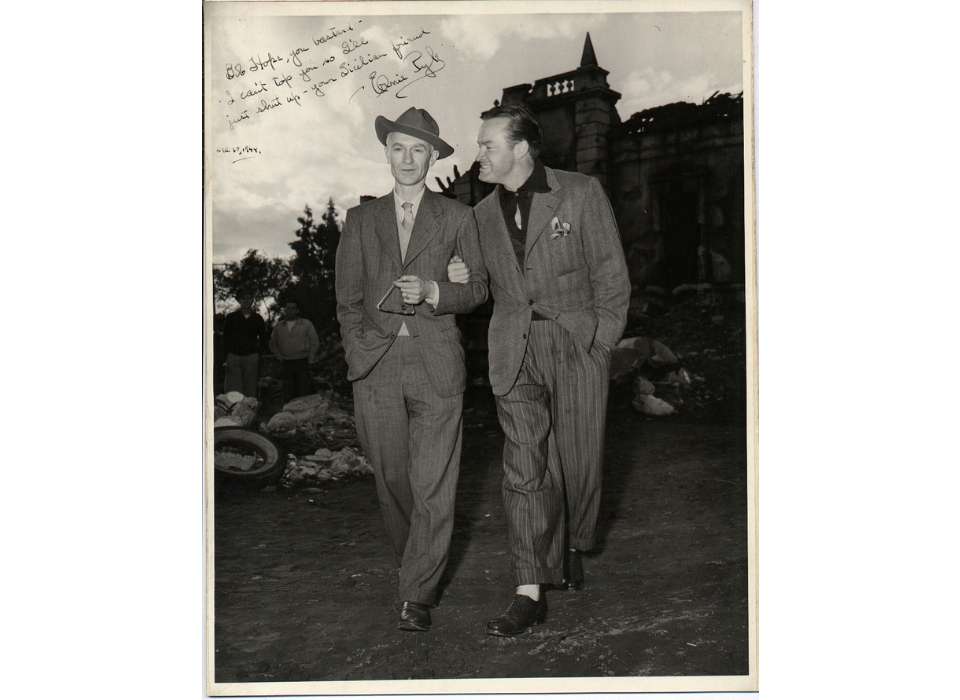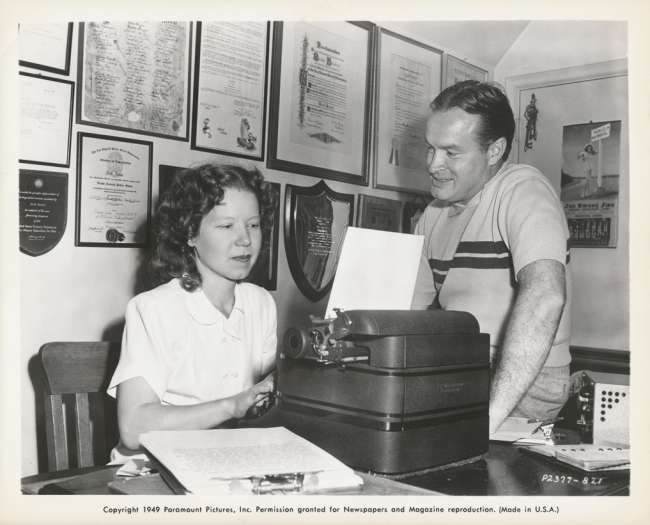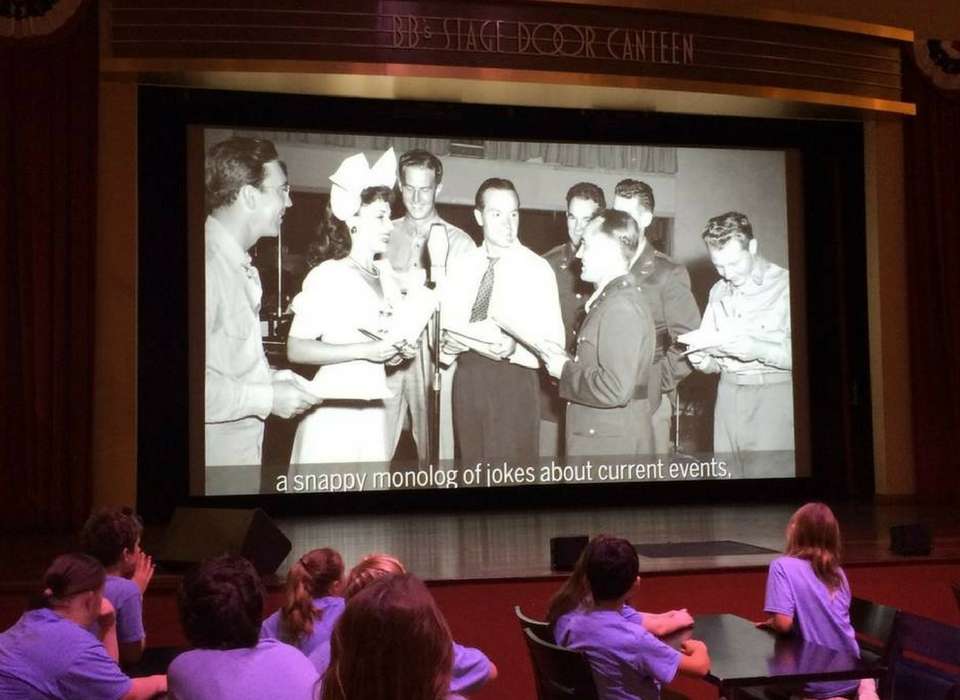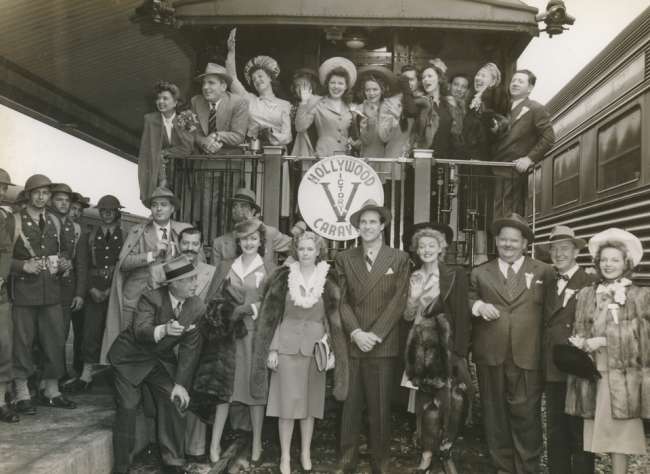When war correspondent Ernie Pyle and comedian Bob Hope crossed paths in the still-active war zone of Sicily in August 1943, it was a meeting of two men fiercely devoted to America’s fighting forces. Pyle had covered the war since the early days of the Blitz when he wrote from London about a city “ringed and stabbed with fire.” Hope, a famous radio personality and film star, had been driven to perform for troops since meeting his first military audiences at March Field in California in May 1941. Both Pyle and Hope saw it as their mission to connect with those in service.
Hope used his energy, talents, and connections to bring a talented troupe directly to the battle zones, entertaining troops as they prepared to go into combat or as they returned. Bringing a bit of home to the boys—“This is what you’re fighting for,” he would famously proclaim as lovely young dancer Patty Thomas appeared on stage—Hope was often referred to as a “Home Front ambassador.” Pyle was every bit the envoy. Throughout the war, he embedded himself with troops, often infantrymen, endearing him to America’s fighting forces. His newspaper column with notes from the field was carried by over 700 American papers. Weekly, he was able to share glimpses of the war with anxious families on the Home Front, desperate to hear from and about their loved ones serving overseas.
By August 1943, Pyle had followed alongside American troops as a correspondent for nearly six months. He was with troops from the Third Infantry Division when “Hope’s Gypsies,” Bob Hope’s traveling troupe, passed through. Over a couple of days, Hope and Pyle connected and experienced life in a combat zone. In the column “Bob Hope Visit is Tonic to Troops” that appeared September 16, 1943, Pyle wrote, “I was in two different cities with them during these raids and I will testify they were horrifying raids. It isn’t often that a bomb falls so close that you can hear it whistle. But when you can hear a whole stack of them whistle at once, then it’s time to get weak all over and start sweating. The Hope troupe can now describe that ghastly sound.”
“I was all for giving the troops a little touch of America through those movie stars, and I can testify that the boys enjoyed and appreciated it.”
– Ernie Pyle, "Brave Men," 1943
After Sicily, Pyle followed along with American forces into Italy and then, eventually Normandy. Pyle’s column about an infantry’s unit’s loss of a beloved commander, “The Death of Captain Waskow,” published in January 1944, became his signature piece. He learned that spring, in late April 1944, he had been awarded the Pulitzer Prize for “distinguished war correspondence” in 1943.
The two men connected again more than a year later on the California film set of The Story of GI Joe, based on Pyle’s columns. In an inscription on a photograph of the two together on the set, designed to look like the bomb-ravaged Sicily, Pyle teased Hope, “Bob Hope, you bastard—I can’t top you so I’ll just shut up—your Sicilian friend, Ernie Pyle Dec. 20, 1944.”
Pyle continued to serve the fighting man until the end of his life at age 44, when he was killed in action on Ie Shima during the invasion of Okinawa on April 18, 1945. Hope outlived Pyle by 58 years. In those decades, he continued to serve military audiences. Hope died at age 100 in 2003. According to Hope’s daughter, Linda, he kept the autographed photo of Pyle framed in his dressing room.
Top photo: Bob Hope and Ernie Pyle, December 1944. Courtesy of the Bob & Dolores Hope Foundation Collection and World Golf Hall of Fame & Museum.
Kim Guise
Kimberly Guise holds a BA in German and Judaic Studies from the University of Massachusetts Amherst. She also studied at the Universität Freiburg in Germany and holds a masters in Library and Information Science (MLIS) from Louisiana State University. Kim is fluent in German, reads Yiddish, and specializes in the American prisoner-of-war experience in World War II.
Cite this article:
MLA Citation:
APA Citation:
Chicago Style Citation:






![Max Fuchs, New York City cantor, sings as Rabbi Sydney [sic] Lefkowitz, Richmond, VA, conducts the first Jewish services from Germany.](/sites/default/files/styles/max_650x650/public/2025-10/image1.jpg)





